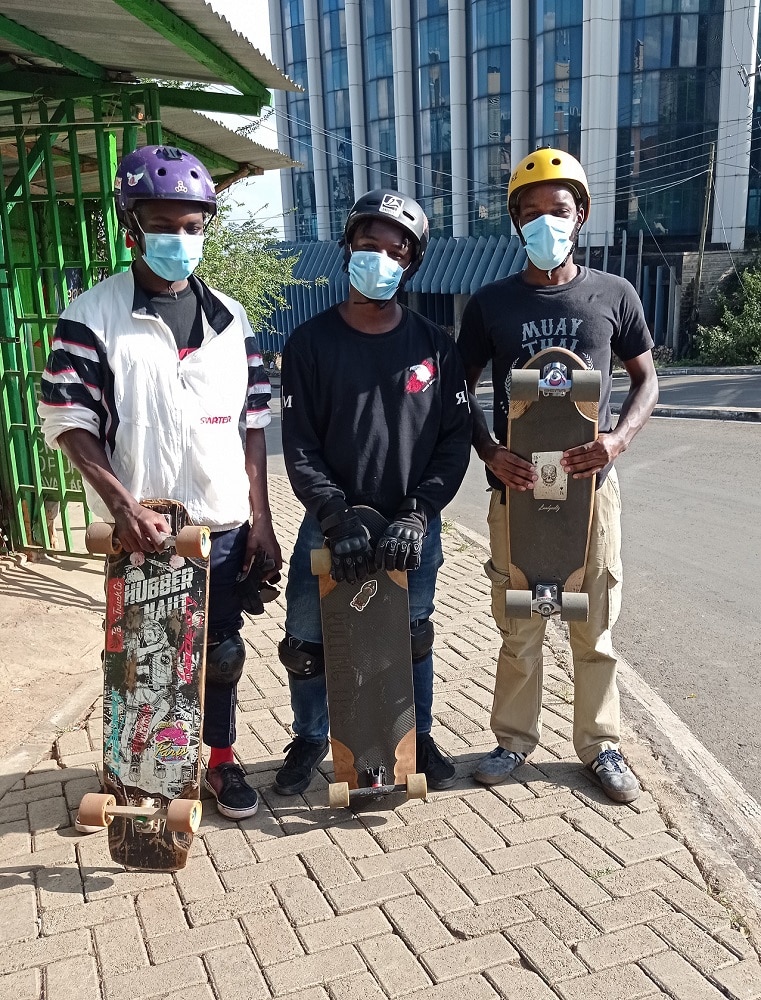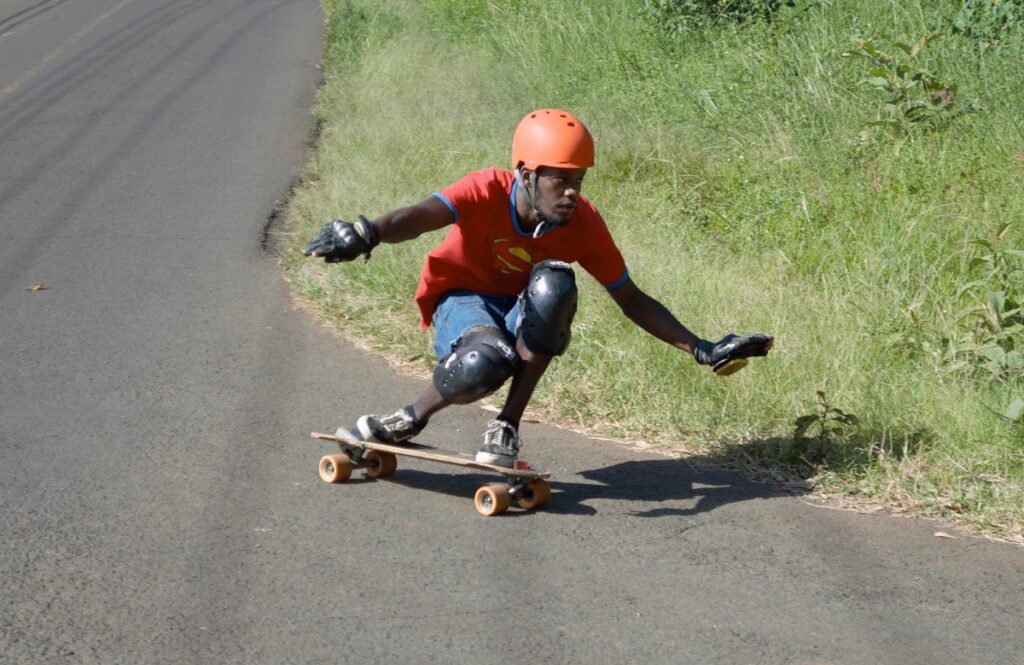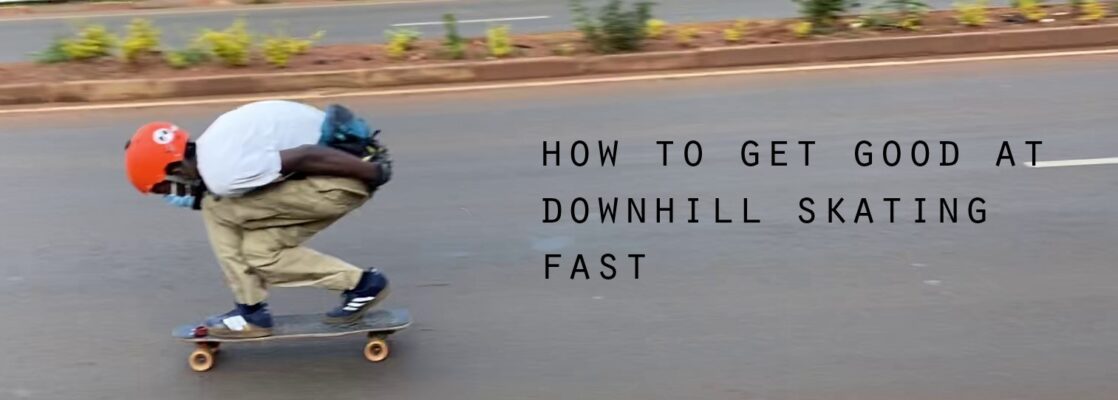Today’s article is a guide to help you get good at downhill skateboarding quickly. Whether you’re a beginner or a pro, you will find I have some useful tips for you. Check it out below.
Quick fixes to get ya good quick
Look ahead, not at what’s immediately in front of you
Don’t get fixated on what’s immediately in front of you when you skate downhill. By this, I mean fixating on oncoming “potential hazards”.
Looking at approaching “potential hazards” (eg a bump in the road, a crack, a pebble etc.), causes you to stiffen up. And when you finally do roll over these “hazards”, they affect you more than they actually should – mainly because you’re stiff.
If you were more relaxed, you’d be able to roll over these things easily without much issue. They wouldn’t affect you as much.
Focusing down the hill allows you to relax and not fixate on things. You’ll be able to skate over rumble, bumps, roughness in the road, etc. like they’re not even there.
A key to skating fast is being loose and relaxed.
Twitch does not = “wobbles”
Just because you skate over something and your truck twitches, doesn’t mean you’re going to wobble. 99% of cases, it’s just your truck providing feedback that you’ve skated over something. If you remain in tuck and remain relaxed, you’re simply going to roll over it with no issue. Don’t react to the twitch.
In the video below, the riders are skating super fast on an imperfect road. Rolling over cracks, pebbles, whatever – you can see their boards twitching beyond belief when they roll over these road imperfections. They stay relaxed and just mob regardless. This is how you should skate too.
But yeah, you can get wobbles – but mostly because of how you react. People get wobbles from twitches because they react to the twitches in an effort to counter and control them. They try to make corrections where none are needed and simply amplify the twitch into something worse.
If they had just stayed relaxed, they would feel the twitch, but it would likely amount to nothing. The trucks would recorrect themselves and keep going straight.
On a personal level, this one took me YEARS to learn. I think it just took a while for the habit to get really cemented in me. Also, because I don’t have experienced riders where I’m at, there was no one to learn from. I had to learn and explore this myself.
Like in life, sometimes the best thing to do in skateboarding is nothing.
Weight management!
Be gentle when you come out of tuck at higher speeds and how much movement you make with your feet when you’re mobbing.
Too many people stand up too quickly out of their tuck. And if you’re doing this to avoid wobbles you’re likely going to make the situation worse – I’ve seen MANY people fall because of this.
You need to be gentle with your movement and how you shift your weight – especially at speed. When you get out of tuck, gently rise to a standing position, putting your back leg to be flat in a gentle way. Finally, always keep most of your weight on your front foot.
Film yourself
Filming yourself allows you to get a 3rd person view of what you’re actually doing.
It’s often difficult to know exactly what lines we’re taking, how fast we’re going, or how we’re going around a corner. Filming often reveals a lot and is key to seeing and correcting a lot of mistakes.
Tighten your back truck “a little” more than your front
I find half to a full turn of the kingpin improves performance in how slides feel and how stable your board is. It’s also especially useful if you have a symmetrical truck setup.
For slides, it allows you to load the back truck up with more weight and pressure. I find that that makes it easier to control the slides too. For stability, it just restricts the back truck a tiny bit more – which is good.
Don’t tighten your trucks too much though.
New bushings and pivots
Bushings dialed in for your weight can you give you pretty much immediate improvements in the ride. They’ll allow you to have more control and stability.
New pivots (Riptide pivots especially) can make your trucks behave way better. They allow for a smoother lean and turn.
You’re going to have to figure out what bushings will work for you. There are some resources online, but I recommend joining the r/longboarding reddit or the Fb/LongboardFamily or Fb/#WhatgearshouldIbuy groups for advice from experienced riders and pros. They’ll be able to help you with your specific situation (eg. deck, trucks, wheels, wheelbase).
Play around with washers
Playing around with your washer configuration can give you the extra lean, or just that extra bit of restriction you need for whatever you want to do.
Warm-up slides and hand drag carving
At the beginning of each session, do 5 heelside slides and 5 toeside slides. You can also add 5 pendulum slides of each if you want to really warm up. I also recommend hand drag carving a couple of times too.
Warming up just allows your body to loosen up and get ready for the session. It allows you to familiarise yourself with your setup again and really understand where your body is at – are you loose, are you flexible enough? Are you feeling good? Off? It’s key if you’re looking for consistency in your performance – which is really what allows you to get good.
More long-term tips
In no particular order.
Quality equipment
You’re going to want gear appropriate for skating and for your skill level.
By appropriate for downhill, I mean you’re going to want a stiff deck, trucks with a baseplate about 45*, and wheels for the type of riding you want to do. All this equipment should come from high-quality brands so you’re ensured they will perform decently.
Learn more about decent downhill gear here.
Cheap equipment is going to hold back your progression. Most of the time cheap gear doesn’t offer reasonable performance and you’re going to struggle to get good, or even skate confidently. Your learning curve will be steeper and you’ll progress slowly.
Decent quality gear isn’t unreasonably expensive. A set of good quality freeride wheels and a pair of high-quality cast trucks cost about $90 together. Any aspiring downhill skater should have these things.
Don’t just ride what “pros” ride
More often that not, the gear and setups pros ride aren’t really “beginner-friendly”. They skate very hard to slide wheels on setups that require a lot of finesse and skill to manage – they’re also incredibly personalized and tuned to their tastes. Simply copy-pasting their setups doesn’t always turn out well.
Stretch
The best skaters in the world all have incredible lower body flexibility and range of motion. If you want to skate well – as a beginner or at a high level, you need to have good lower flexibility. And more often than not, the people who progress fastest have great lower body flexibility. These are facts.
So yeah, stretching is incredibly important in downhill skateboarding. It allows you to recover from sessions quicker and keeps your body loose and flexible. It also allows your body to perform at a consistent level – you’re going to be able to start most sessions feeling good.
Finally, you’re going to be able to get into those awkward sliding and DH positions with ease. This is key.
I recommend doing dynamic stretches before a session, and static stretches after. Dynamic stretches warm up and loosen your body. Static stretches are best done when you’re warm.
Overall, the goal is to make your body less of a factor that holds back your progression. In general, a key to getting good fast is to remove as many limiting factors from your path.
Find a community
Finding people to skate with provides a sense of belonging and stoke. Both of these things are important. They’re going to keep you looking forward to sessions and will get you out of the house to skate.
Skating with other people also allows for second opinions, for you to try out other gear and a chance to get in-person advice. You also get the low down on where all the good downhill spots are at.

Finally, seeing people do stuff in person can give you an idea of what you can also do. Sometimes we get stuck on doing something a certain way because we have no references of whats possible.
Learn to skate alone
As much as skating with people is nice, learn to skate alone. Skating is an individual journey at the end of the day, and more often than not, people aren’t always going to be available to skate with you. Or have the same skill level (or desire) necessary to tackle some hills.
Learning to skate alone allows you to have the frequency of skating you need to get better, and the courage to tackle some obstacles alone. You also learn you don’t need to skate with others to have a good session or enjoy skating.
Frequency – skate often enough
Understandably, not everyone can skate frequently. But if you can squeeze 3, two-hour sessions in a week, you’re going to see a lot of improvements and consistency in your skating. Remember to stretch before and after those sessions too.
Skating frequently allows you to build up on whatever you did in the last session. If your sessions are far apart, you’re always re-learning somethings at the beginning of a session. And sometimes, everything feels too “foreign” for you to skate in a confident way, or in a way where you can learn something new confidently.
Focus on getting good on one corner
The quickest way to get good at turning and sliding is by practicing it on one corner frequently. Find a corner that you can spot by yourself and skate it a lot. Take note of what you are doing and try to improve on it.

Skating one thing frequently allows you to find out what your weaknesses are pretty quickly. You can also quickly note any improvements you’ve made.
If you’re more experienced, skating a single road and working on your lines on it (and whatever you suck at doing), usually helps you become a much better skater. The experience from this single road is usually transferable to other roads too.
Try other roads too
As much as sessioning a single corner can be useful, skate a variety of roads. Different roads require that you skate them differently and this can be an eye-opening experience.
A lot of the time, the experience of having to skate differently can open your eyes to ways to skate your local spots differently or better. It also shows you what you suck at and what you need to work on.
Protective gear
Protective gear simply allows you to fall and slam, and walk away unharmed. You can then carry on your session and keep skating as though nothing happened – as opposed to being sidelined and in pain. You can avoid injuries that would put you out for weeks.

So yeah, they just allow you to carry on skating. If you want to get good quickly, you don’t want to do anything that will stop you from skating. Also, getting hurt sucks.
You’re going to want a certified helmet, a good pair of knee pads, slide gloves, and hip pads (you bust your ass more than you expect).
Avoid getting hurt – skate within your limits
Anything that interrupts your skating should be avoided, so avoid getting hurt.
You can avoid getting hurt by only skating roads (and doing things) within your skill level, and only slightly pushing your limits – only in places where the environment is sorta controlled and you can bail sorta safely.
Attend closed road events
Closed road skate events are essentially when an organiser closes a given road so riders can skate it for a day – usually two. The line it with hay bales and put marshals on most corners. You pay an event fee and can basically skate the road for an entire day.
They’re great because they are the safest environment possible to push your limits and try new things on your board.
A good example of an event would be the Tepes and Tacos freeride. Check it out below.
Learn about race lines
Race lines are basically the fastest line through a corner. Learning about this will allow you to find out where you should slow down (i.e where you should slide) and how you should approach a corner. It will also show you how to take a corner safely.
Everyone, even non-racers should learn about race lines. They will allow you to make smarter decisions at corners and down the hill.
Learn to slide/skate within your lane
Self-explanatory, but learn to do everything you need to do in one lane. Whether it is pre-drifting, doing a pendy, taking a corner, etc. Learning to do it all in a small space will make you a much better skater.
You’re going to learn a lot of technique, control and you will gain a little bit more finesse. You’re also going to open your eyes to all the new lines you can take and you’ll basically get to explore the limits of what you can with your board.
Admittedly, this one is significantly more challenging. It will be better suited for more advanced riders. It is also a critical skill if you want to skate open roads safely.
Building skills – it takes time
As much as I have given you these tips, it’s still going to take time to get good. I simply advise you to embrace the suck and just enjoy skating at whatever skill level you’re at. If you can have fun, you’re doing it right.
So yeah, don’t try to rush things and don’t take shortcuts. Take your time and enjoy yourself. If you try rush things, you often get hurt and will experience setbacks. Enjoy the process cause you in it innit.
Finally, don’t compare yourself to others. Everyone has their own individual journey with skateboarding. So don’t look at your friend getting good quickly and feel bad. Take your time and work through your own difficulties and issues.
What do you think? Are these tips helpful?
If you have any tips you want to share or any you disagree with on this list, comment below, and let’s talk about it. Otherwise, I think the most helpful tip might be skating frequently (stretching). Get out and skate (and stretch) as often as you can, you’ll naturally get good.
And yeah, unfortunately there is no magic pill. You’re going to have to work hard to get good.
Big thanks to all my patrons for the support – Jed, SuperbadJuju, Mowgii, Bryan, Andrew, Jan, Jay, Owen, Samil, Daniel, Alex, Kasajja, Leah, Helge, DeLacoste, and Justin. I couldn’t write articles like this without you guys’ support.

3 comments on “How to get good at downhill skateboarding FAST”
Lourenço Crispim
January 21, 2021 at 3:19 amThank you so much for your passionate work! Keep it bro! Cheers from Portugal <3
Antonio
January 21, 2021 at 8:08 pmhats a really good article!
Can add a bit:
– Do skate experimets (like in science):
I try to focus on just one factor and just change this factor and see how riding changes. For example you can always look at the same spot when doing a slide and observe what changes in your riding.
You can change factors on your body (eg. shoulder rotation, hip position, arm movement etc) or on your gear (different wheel) or psychological factors (e.g. looking 30m ahead insteat of 10) and see how this one factor changes your riding.
When changing just one factor it has a causal relationship to the outcome (e.g. slide) while changing more factors at the same time you wont know what made your slide better or worse for example
– Plan-execute-reflect-repeat a slide/run:
Before doing a slide or run I sometimes plan on what I want to do exactly (e.g. 15m slide at the exact spot on the road and then turn). Then I try to do it exactly as palnned and reflect on the slide or run afterwards while iam going up the hill
memory and learning is recalling what you do not just repeating
Discover new factors to use: For example where you look. Look 30-50m ahead not on your board or body. Or plan your than line and look at them later how it looks different from imagined. Or compare switch to normal riding to find important factors that makes it different.
Robert Hogward
March 6, 2021 at 2:29 pmVery informative post, thank you for taking the time to write this all out!
The construction and type of material used affect how the board rides, flips and grinds. Trucks are usually diecast from a combination of metal, steel, brass. Some types incorporate aluminum parts and hollow axles to reduce overall weight. I never buy plastic ones because these types are too risky to ride on.